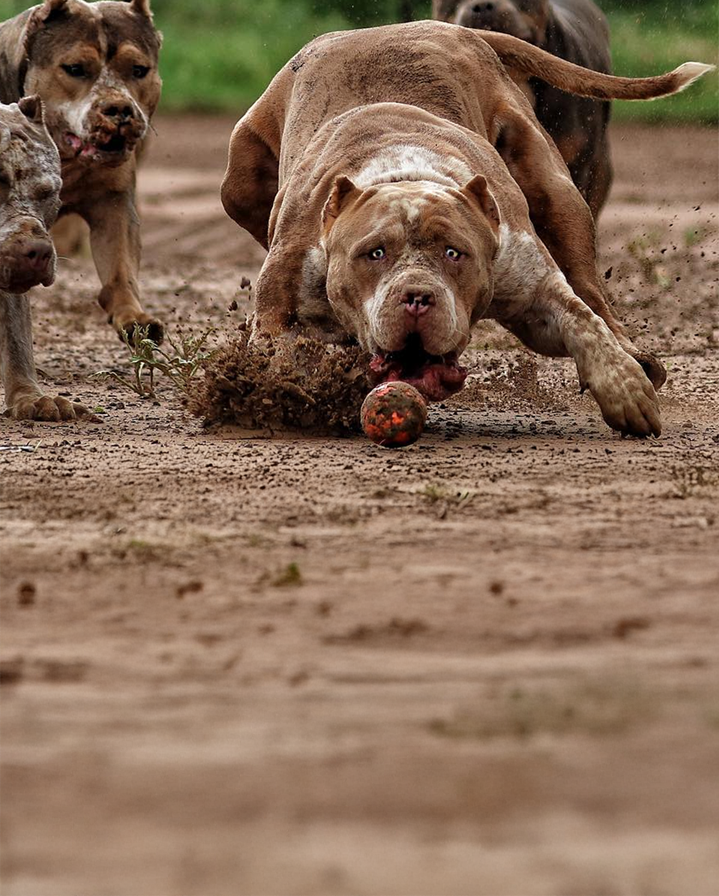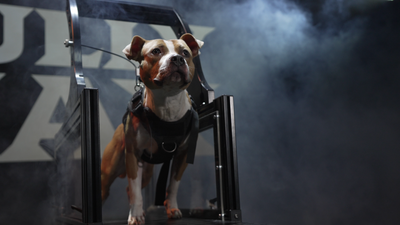How to Break Up a Dog Fight and How to Prevent Them
Pit bulls are a loyal and loving breed of dog with countless good qualities. And as a proud owner of this wonderful breed, it’s your responsibility to keep your dog—and other dogs in the area—safe and happy.
In order to do that, it’s important to take the proper steps to prevent dog fights.
In the right circumstances, all dogs will fight. But pit bulls fights can be more frequent and more severe if you don’t know how to prevent them.
A dog fight might sound scary, but the truth is that you can easily prevent them by making a few smart decisions. And if a fight does break out, you can break it up quickly as long as you know what to expect and how to react.
A Few Things You Need to Understand About Pit Bulls
- Pit bulls were bred for fighting. This doesn’t make them mean, bad, or evil; it’s just their heritage (similar to how many other dogs are bred for hunting).
- Other dog breeds will act out submission signals when they want to stop fighting, which usually signals the end of the fight. But pit bulls may ignore these signals, which means that a pit bull fight can lead to serious damage—or worse—if the fight is not broken up.
- Pit bulls are “people” dogs. They love spending time with people and enjoy attention and love from your family. They do not need another dog around to be happy.
What Causes Dogs to Fight?
- Dog fights can happen suddenly and without warning. Fights may be preceded by growling, barking, or posturing, but they may not be. Fights can even occur between dogs that have been close friends for years. And once two dogs have fought before, they are more likely to fight again in the future.
- Fights can be triggered by seemingly innocent causes, such as excitement and stimulation from seeing a squirrel or other small animal run by. Fights can also escalate from rough-housing, competing over a toy, or even out of jealousy (for example, if one dog is getting more attention from the family).
- Sexual hormones can cause dogs to behave much more aggressively than normal.
- Finally, tension between dogs can cause them to fight. And one sure source of tension is an unclear pecking order. If you have a fighting breed of dog, make sure to train it properly so that it clearly understands its place in the social hierarchy.
How to Prevent Dog Fights
The #1 best way to prevent dog fights in your home is to make the pit bull your only pet. As we mentioned above, pit bulls are “people dogs” who enjoy spending time with your family and do not need another dog to be happy.
If there’s no other dog around, there’s no one for your pit bull to fight with.
If you prefer to have more than one dog, here are 8 tips to minimize any chance of fighting:
- Get one male and one female. Same-sex dogs are more likely to fight. Two males (or two females) are much more likely to fight than a male and a female. This is true of every breed, not just pit bulls, because two dogs of the same sex are likely to see each other as rivals.
- Release pent-up energy by exercising your dogs. If dogs are not exercised frequently enough, they will build pent-up energy. This can lead to dog fights.
- Walk your dogs together. Walking your dogs together forms a stronger pack. Dogs that have formed a strong pack are less likely to fight.
- Spay or neuter your pit bulls as early as possible. Sexual hormones cause them to be much more aggressive than usual.
- Never leave your pit bull unsupervised with other animals. If you aren’t around to watch them, each pit bull should be crated or kept in a separate room.
- Watch your dogs when they are playing. Even innocent rough-housing can escalate into a fight if you aren’t paying attention. Remember, as the human you are the leader of the pack—it’s your job to set limits on the dogs’ behavior.
- Pick up dog toys, bones, and food when they’re not being used. Two dogs who stumble across a toy or a bone could start fighting over it.
- Always keep your pit bull on a leash when you take them for a walk, and keep them away from other unleashed dogs. This means that you should NEVER bring an adult pit bull to an off-leash dog park.
What If A Fight Does Break Out?
If your dog does start fighting, it’s important not to panic. Screaming and panicking will not stop a fight, it will only intensify it. By staying calming and using the proper tools, you can break up the fight quickly.
How to break up a dog fight, Method 1:
The two things you will need are a break stick (to pry the dog’s mouth open) and a collar or leash (to pull the dogs apart). It's important to keep collars on your dogs at all times. Breaking up a dog fight is more difficult when the dogs are not wearing collars.
A break stick is a stick you insert between the dog’s back teeth. Then, twist the stick to pry the dog’s mouth open.
Once the dog’s mouth is open and the hold is broken, grab their collars or leashes and pull UP. Avoid pulling them apart face to face at ground level, it will only make them fight more intensely. Separate the dogs as quickly as you can—by putting them in separate rooms, or tying one to a tree while you remove the other.
How to break up a dog fight, Method 2:
One of the FASTEST and SAFEST way to break up a dog fight is by grabbing both dogs by their collars and holding them in in the air as high as possible, so the dogs lose oxygen. Without oxygen, they will not be able to hold their grip.
Yes, one dog will usually lose oxygen before the other, but as long as both dog's front feet are off the ground and the collar is applying direct pressure to bottom of neck (as high up on neck as possible) they WILL lose oxygen and release their grip.
Do not hold the dogs in the air ANY longer than necessary — and that is the moment the dog releases its grip.
NEVER scold or hit your dog after a fight. Speak quietly to the dog to sooth it and reduce the arousal level. After the fight is over, it's important that you create peace, harmony, and balance.
The idea of a dog fight might sound scary, but as long as you follow this advice you shouldn’t have anything to worry about. Just be mindful of your dog’s heritage, and you’ll have a loving family member who will be a source of happiness for years to come.









138 comments
The Humane Society in my city has an outdoor adoption event on weekends. Lots of fighting breeds are present. Manager (“Boss Lady”) allows volunteers to open the crates and walk the dogs. Volunteers also encouraged to sit with the dogs on the grass. Volunteers have no training other than being told to keep the dogs away from each other. I was sitting with my leashed pitbull, relaxing. She was quiet and calm. Suddenly she bolted and ran 20-30 yards towards a leashed Akita standing on leash outside a crate. Vicious dog fight ensued. I had been knocked out of my chair and fell on the lawn, looking backwards to see where my dog had run off to. I believe the leather gloves I was wearing prevented my fingers from being broken when my dog broke loose and bolted. Volunteers said the Akita was giving my dog a “vibe”. The Akita was known to cause trouble at other adoption events. One thing to another the two dogs were taken to animal control and euthanized. I sought out the Boss Lady to tell her what happened. She would not discuss with me, ignored me, told me I could not walk the dogs anymore. I told in her in so many words to F herself as I hadn’t been walking my pooch, just chilling in a camp chair, giving love to the pittie. It would have been empathic for this manager to ask if the volunteer was OK. I was not. My hands shook for hours, with so much cortisol flooding the body. In the following days after this incident I filed reports with national animal abuse databases, the state certifying agency for rescue groups (PACFA), and called numerous pit bull rescues to learn what went wrong at this event. My analysis: incompetent manager, lack of proper training for volunteers, allowing animals to be removed from the crates, cheap thin leashes. No proper supervision of volunteer corps.
Based on this narrative, the aggression of Milo seemed to be hierarchy-related. The social maturity of Stitch (social maturity in puppy occurs around 3 years of age) resulted to an unstable hierarchy. Although aggression can be corrected, the process takes time and effort. The correction process involves the following.
1. Positive reinforcement of muzzles. Take the effort to associate muzzles with good experiences such as treats and lots of praises. Do this patiently, especially for Milo.
2. Avoid triggers before the desensitization and counter-conditioning training. Keep both dogs in separate places during muzzle training. Allocate separate food, treats, toys, preferred resting places, and owner attention. Do not allow a common place for both of the dogs.
3. Show preference to Milo. Selecting the older dog to receive preference such as first access to resources such as food, treats, favorite resting places, toys, having the leash put on first, access to door ways, and attention reduces conflict and unpredictability which will provide structure.
4. Desensitization and counter-conditioning is an effective method in these cases. Upon establishing the muzzle training, you can gradually expose the dogs to each other while they learn positive experiences occur when the other dog is near. While the dogs are leashed and muzzled, each handler and dog should be far enough away from the other handler and dog that neither dog shows any signs of aggression. The dogs are then asked to perform obedience commands and rewarded with treats, play or attention. For each consecutive session, gradually decrease the distance between dogs during the training. If aggressive behavior is observed, increase the distance and proceed with distance reduction more slowly.
5. Help from a canine behaviorist and a veterinarian may also be needed. For instance, fluoxetin is an SSRI which is a common medication prescribed for aggression.
In the end, the most important thing to consider is the safety of the animals and the people around them. In futile cases, re-homing may be recommended as it is the best option for everyone.
My boys recently fought. I have 3 pit bulls in my house. Two males and one female. My male and female had a litter 3 yrs ago and we kept their 1st born which is a male. There has never been a known issue until 12/6/23. Milo our oldest male (who is the father of our other male) started fighting our younger male Stitch. Our female Lola (the mother) thankfully backed out of the room. My son made the mistake of trying to separate the boys. When doing so one of the males who we think was Stitch, latched onto my adult son’s wrist and continues to have Milo’s side of his face/ear in his mouth as well. Stitch was clearly afraid and defending himself. I made the mistake of trying to hit the dogs to have them release my son’s wrist. What worked was squirting them with a water bottle. Then pushed one dog out of the room and closed the door. Long story, son was rushed to the hospital and had to have surgery on his wrist. Took Milo to the vet and had him treated for his injuries. About a week later we had both boys neutered and have them separated and rotating in the house and backyard. Our female is doing good with both the males and rotation. My question is, we are trying to re-introduce our boys. We bought them muzzles which I think made Milo aggressive and had him in his harness and leash. Stitch didn’t like the muzzle either but army crawled out to the backyard on his harness and leash. We tried walking the dogs around the backyard and that’s when Milo launched at Stitch. Good thing we had them on leashes and with muzzles. Separated them again and haven’t tried to do anything further just yet. Maybe the muzzles agitated them. Maybe being in our backyard. Now our thinking and a suggestion from the human society is to walk them out front on opposite sides of the street. Keep doing that until we can have them calmly back together and supervised. What are your thoughts regarding this?
Turn them upside down. Then the dogs will loosen their grip & sometimes let go. That’s when you take them away. U can also suffocate them by placing your hand over the nose while grabbing behind the teeth, through their mouth. I advise the firstcmethod.
This is a great article, but I don’t know why it is focused on fighting amongst pit bulls. I have a pitbull and a dalmatian, both rescues that I rescued as puppies. The dalmatian is the aggressor and always starts the fight. We know the triggers now and work hard to avoid them. The pit is great with other dogs and has never started a fight. I just want to advocate that fighting is not just a pitbull dog thing. It runs across any/all breeds.